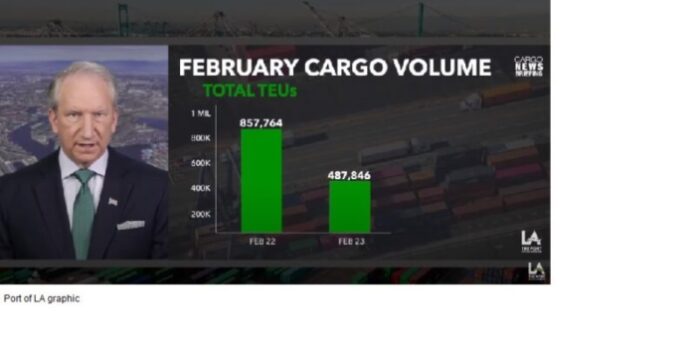-
Container throughput at the Port of Los Angeles in February was “the fewest since March 2020” as 487,846 TEUs, down 43% from the year-ago volume
-
Port executive director Eugene Seroka expects China’s reopening will improve trade in coming months as there will be an uptick in overseas production
-
Volume at the port in March will be close to 600,000 TEUs, Seroka says
Container cargo volume at the Port of Los Angeles dropped to its lowest in 3 years in February 2023, but the port’s top official expects business will improve in coming months as more factories in China reopen following the lifting of strict Covid restrictions.
The port announced on March 17 that it processed 487,846 twenty-foot equivalent units (TEUs) in February this year, down 43% from the previous February’s all-time record.
Eugene Seroka, executive director of the port, attributed the throughput contraction last month to an overall global trade slowdown, extended Lunar New Year holiday factory closures in Asia, overstocked US warehouses and importers’ shift away from West Coast ports.
“While we expect more cargo crossing our docks in March, volume will likely remain lighter than average in the first half of 2023,” said Seroka, who described the February volume as “the fewest since March 2020”.
For March, Seroka said he expects volume at the port will be close to 600,000 TEUs. In the same month last year, the port handled 958,674 TEUs, helping lift the Q1 2022 throughput to a record 2,682,034 TEUs, its best first quarter.
But Seroka said there are still a few bright spots in the coming months, such as Lunar New Year having passed and Covid restrictions in China have eased considerably.
“So, we should see an uptick in overseas production and many of those ships idled are well positioned off the coast of China waiting for cargo,” Seroka said.
Los Angeles received 61 container vessels last month compared with 93 in February last year, he said, illustrating the impact of the cargo shift on the port and other gateways in California.
Seroka has been personally campaigning to attract back scores of US importers and exporters who have switched to East Coast ports since mid-2022 to avoid delays due to congestion and a potential union action at West Coast ports.
“We’re using this volume lull to focus on new data and infrastructure initiatives to improve efficiency in preparation for increased throughput,” added Seroka, who said in his weekly televised briefing that he had just returned from a trade mission to Japan.
February 2023 loaded imports reached 249,407 TEUs, down 41% compared with the previous year. Loaded exports came in at 82,404 TEUs, a decline of 14% year on year. Empty containers landed at 156,035 TEUs, 54% y-o-y fewer, according to statistics from the port.
Two months into 2023, total container volume at the San Pedro Bay gateway was 1,213,860 TEUs, a 30% decline from 1,723,360 TEUs in February last year.
Seroka said the port recorded 30 cancelled sailings in February that were reminiscent of the early days of the Covid-19 pandemic, when the contagion crept into the port and its twin, the Port of Long Beach, infecting thousands of workers and causing numerous deaths.





